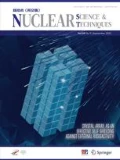Abstract
In order to investigate the tritium behaviors in Hastelloy N alloy in molten salt reactor, first-principles calculations are used to study the interaction between hydrogen and 4d transition metal alloying atom in nickel-based alloy. The interaction energies between 4d elements and H are calculated. Atomic size effects and electron distribution effects are analyzed. The hydrogen–4d interactions are compared with the hydrogen–3d interactions calculated in our previous work.





Similar content being viewed by others
References
D. LeBlanc, Molten salt reactors: a new beginning for an old idea. Nucl. Eng. Des. 240, 1644–1656 (2010). doi:10.1016/j.nucengdes.2009.12.033
A Technology Roadmap for Generation IV Nuclear Energy Systems, in US DOE Nuclear Energy Research Advisory Committee and the Generation IV International Forum, Dec 2002, GIF-002-00. https://zh.scribd.com/document/208741057/Gen-IV-Roadmap
F.F. Noecker II, J.N. DuPont, Metallurgical investigation into ductility dip cracking in Ni-based alloys: part II. Weld. J. 88, 62S–77S (2009)
M.R. Louthan, D.E. Rawl, G.R. Caskey et al., Hydrogen embrittlement of metals. Mater. Sci. Eng. 10, 357–368 (1972). doi:10.1016/0025-5416(72)90109-7
A. Barnoush, H. Vehoff, Recent developments in the study of hydrogen embrittlement: hydrogen effect on dislocation nucleation. Acta Mater. 58, 5274–5285 (2010). doi:10.1016/j.actamat.2010.05.057
N. Novakovic, J.G. Novakovic, L. Matovic et al., Ab initio calculations of MgH2, MgH2: Ti and MgH2: Co compounds. Int. J. Hydrog. Energy 35, 598–608 (2010). doi:10.1016/j.ijhydene.2009.11.003
L. Qin, C. Jiang, First-principles based modeling of hydrogen permeation through Pd-Cu alloys. Int. J. Hydrog. Energy 37, 12760–12764 (2012). doi:10.1016/j.ijhydene.2012.06.029
W. Liu, Y. Qian, D. Zhang et al., First-principles calculations of the interaction between hydrogen and 3d alloying atom in nickel. J. Nucl. Mater. 465, 254–259 (2015). doi:10.1016/j.jnucmat.2015.06.001
Q.M. Hu, D.S. Xu, R. Yang et al., First-principles investigation of solute-hydrogen interaction in a alpha-Ti solid solution. Phys. Rev. B 66, 064201 (2002). doi:10.1103/PhysRevB.66.064201
Y.J. Li, S.E. Kulkova, Q.M. Hu et al., Interaction between hydrogen and the alloying atom in palladium. Phys. Rev. B 76, 064110 (2007). doi:10.1103/PhysRevB.76.064110
P. Hohenberg, W. Kohn, Inhomogeneous Electron Gas. Phys. Rev. B 136, B864 (1964). doi:10.1103/PhysRev.136.B864
W. Kohn, L.J. Sham, Self-consistent equations including exchange and correlation effects. Phys. Rev. 140, 1133 (1965). doi:10.1103/PhysRev.140.A1133
G. Kresse, J. Furthmuller, Efficient iterative schemes for ab initio total-energy calculations using a plane-wave basis set. Phys. Rev. B 54, 11169–11186 (1996). doi:10.1103/PhysRevB.54.11169
D. Connetable, Y. Wang, D. Tanguy, Segregation of hydrogen to defects in nickel using first-principles calculations: the case of self-interstitials and cavities. J. Alloy. Compd. 614, 211–220 (2014). doi:10.1016/j.jallcom.2014.05.094
S.N. Sun, N. Kioussis, S.P. Lim et al., Impurity effects on atomic bonding in NI3AL. Phys. Rev. B 52, 14421–14430 (1995). doi:10.1103/PhysRevB.52.14421
Author information
Authors and Affiliations
Corresponding authors
Additional information
This work was supported by the “Strategic Priority Research Program” of the Chinese Academy of Sciences (No. XDA02020200), and the National Natural Science Foundation of China (No. 51601212).
Rights and permissions
About this article
Cite this article
Liu, WG., Qian, Y., Zhang, DX. et al. Theoretical study of the interaction between hydrogen and 4d alloying atom in nickel. NUCL SCI TECH 28, 82 (2017). https://doi.org/10.1007/s41365-017-0235-6
Received:
Revised:
Accepted:
Published:
DOI: https://doi.org/10.1007/s41365-017-0235-6



